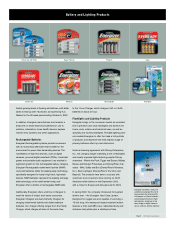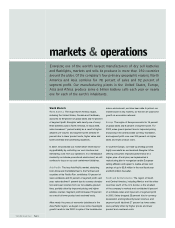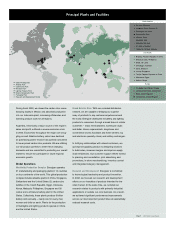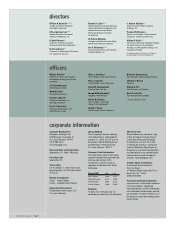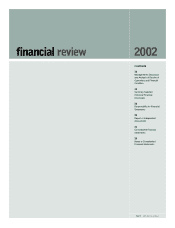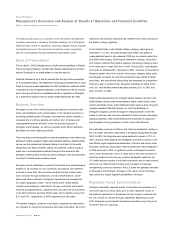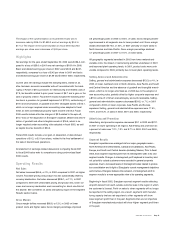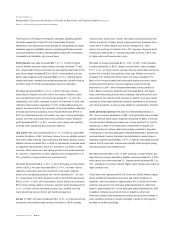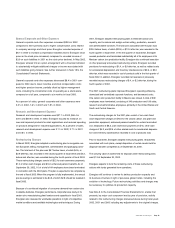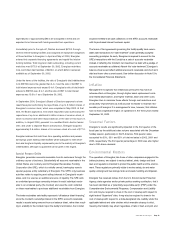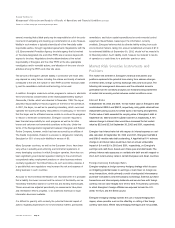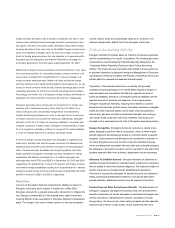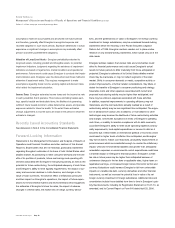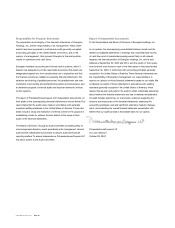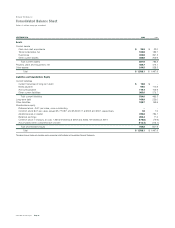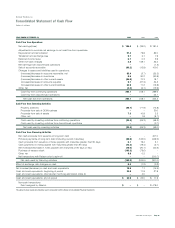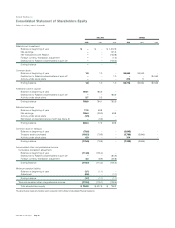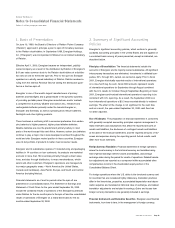Energizer 2002 Annual Report Download - page 17
Download and view the complete annual report
Please find page 17 of the 2002 Energizer annual report below. You can navigate through the pages in the report by either clicking on the pages listed below, or by using the keyword search tool below to find specific information within the annual report.
expenditures of approximately $80.0 are anticipated in 2003 and are
expected to be financed with funds generated from operations.
Immediately prior to the spin-off, Ralston borrowed $478.0 through
several interim-funding facilities and assigned all repayment obligations
of those facilities to Energizer. In April and May of 2000, Energizer
entered into separate financing agreements and repaid the interim-
funding facilities. Total long-term debt outstanding, including current
maturities was $175.0 at September 30, 2002. Energizer maintains
total committed debt facilities of $625.0, of which $450.0 remained
available as of September 30, 2002.
Under the terms of the facilities, the ratio of Energizer’s total indebtedness
to its EBITDA cannot be greater than 3-to-1 and the ratio of its EBIT to
total interest expense must exceed 3-to-1. Energizer’s ratio of total indebt-
edness to EBITDA was .8 to 1 and the ratio of EBIT to total interest
expense was 13.6 to 1 as of September 30, 2002.
In September 2000, Energizer’s Board of Directors approved a share
repurchase plan authorizing the repurchase of up to 5 million shares of
Energizer’s common stock, which was completed in May 2002. At that
time, the Board approved a new share repurchase plan authorizing the
repurchase of up to an additional 5 million shares of common stock, of
which no shares have been repurchased as of the date of this report. In
addition, in August 2002, pursuant to a modified Dutch Auction tender
offer, and under a separate Board authorization, Energizer acquired
approximately 2.6 million shares of its common stock at a cost of $77.0.
Energizer believes that cash flows from operating activities and periodic
borrowings under existing credit facilities will be adequate to meet short-
term and long-term liquidity requirements prior to the maturity of Energizer’s
credit facilities, although no guarantee can be given in this regard.
Special Purpose Entity
Energizer generates accounts receivable from its customers through the
ordinary course of business. Substantially all accounts receivable in the
United States are routinely sold to Energizer Receivables Funding
Corporation (the SPE), which is a wholly owned, bankruptcy remote
special purpose entity subsidiary of Energizer. The SPE’s only business
activities relate to acquiring and selling interests in Energizer’s receiv-
ables, and it is used as an additional source of liquidity. The SPE sells
an undivided percentage ownership interest in each individual receiv-
able to an unrelated party (the Conduit) and uses the cash collected
on these receivables to purchase additional receivables from Energizer.
The trade receivables sale facility represents “off-balance sheet financing,”
since the Conduit’s ownership interest in the SPE’s accounts receivable
results in assets being removed from our balance sheet, rather than result-
ing in a liability to the Conduit. Upon the facility’s termination, the Conduit
would be entitled to all cash collections on the SPE’s accounts receivable
until its purchased interest has been repaid.
The terms of the agreements governing this facility qualify trade receiv-
ables sale transactions for “sale treatment” under generally accepted
accounting principles. As such, Energizer is required to account for the
SPE’s transactions with the Conduit as a sale of accounts receivable
instead of reflecting the Conduit’s net investment as debt with a pledge of
accounts receivable as collateral. Absent this “sale treatment,” Energizer’s
balance sheet would reflect additional accounts receivable and short-term
debt and lower other current assets. See further discussion in Note 15 to
the Consolidated Financial Statements.
Inflation
Management recognizes that inflationary pressures may have an
adverse effect on Energizer, through higher asset replacement costs
and related depreciation, and higher material, labor and other costs.
Energizer tries to minimize these effects through cost reductions and
productivity improvements as well as price increases to maintain rea-
sonable profit margins. It is management’s view, however, that inflation
has not had a significant impact on operations in the three years ended
September 30, 2002.
Seasonal Factors
Energizer’s results are significantly impacted in the first quarter of the
fiscal year by the additional sales volume associated with the December
holiday season, particularly in North America. First quarter sales
accounted for 33%, 33% and 35% of total net sales in 2002, 2001 and
2000, respectively. The first quarter percentage in 2000 was also higher
due to Y2K-driven demand.
Environmental Matters
The operations of Energizer, like those of other companies engaged in the
battery business, are subject to various federal, state, foreign and local
laws and regulations intended to protect the public health and the environ-
ment. These regulations primarily relate to worker safety, air and water
quality, underground fuel storage tanks and waste handling and disposal.
Energizer has received notices from the U.S. Environmental Protection
Agency, state agencies and/or private parties seeking contribution, that it
has been identified as a “potentially responsible party” (PRP) under the
Comprehensive Environmental Response, Compensation and Liability
Act, and may be required to share in the cost of cleanup with respect to
eight federal “Superfund” sites. It may also be required to share in the
cost of cleanup with respect to a state-designated site. Liability under the
applicable federal and state statutes which mandate cleanup is strict,
meaning that liability may attach regardless of lack of fault, and joint and
ENR 2002 Annual Report Page 15


